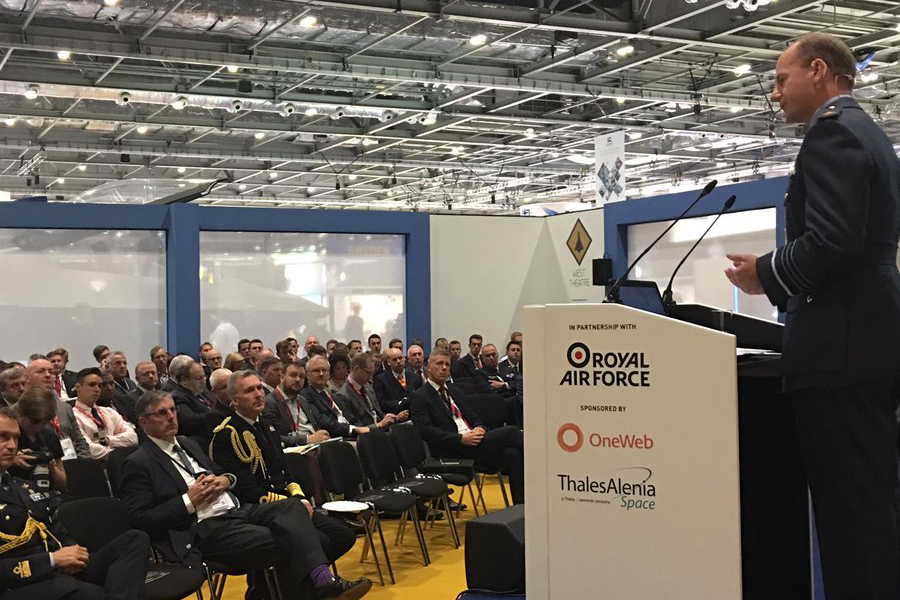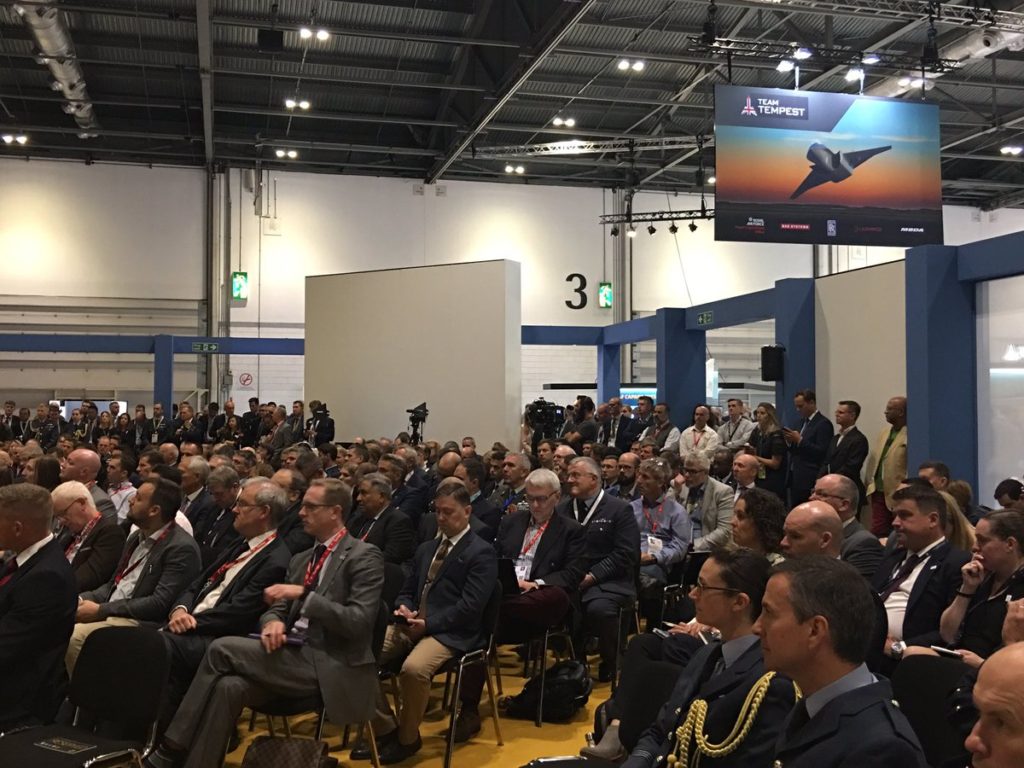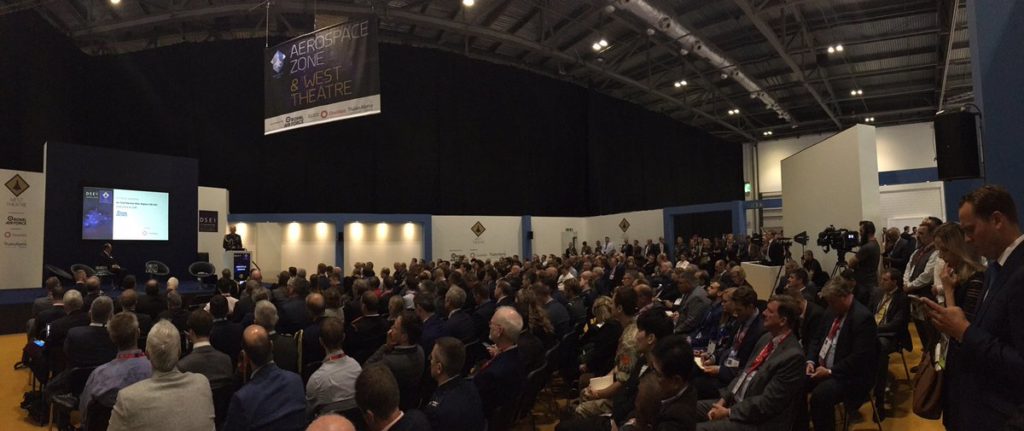Date: 12 Sep 2019
This notice appeared on the MOD RAF’s website. We thought it worth presenting the speech in full as it provides some interesting insights into the future strategy of the RAF. It was given to an audience of industry and military people at the UK defence exhibition, DSEI, so has a bias to the equipment side things. That said, it provides a good overview of life from the perspective of the “Boys in Blue”.

A very good morning everybody. I am delighted to be back at DSEI, which continues to grow in scale and stature as a world leading defence equipment exhibition. Well done the team at Clarion Events
Having been Chief of the Air Staff for just over a month, there are plenty of things I would like to talk about this morning but you’ll understand why I’m going to focus on the Royal Air Force’s equipment programme and the truly impressive things we do with that equipment; all of course underpinned by our vital relationships with allies and with industry partners in the aerospace, space, cyberspace and other technology sectors.
Those are relationships on which our country’s future security and prosperity depend. Partnering and collaboration is as important as it has ever been because these are challenging times. The international system that has existed since 1945, that we rely on for our security and prosperity, is being eroded by states like Russia, China and Iran actively destabilising the world order, challenging our security, stability and prosperity.
We operate today in a state of constant competition and confrontation, with threats to our nation diversifying, proliferating and intensifying rapidly. As CDS remarked recently, it is hard to remember a time when the strategic and political context was more uncertain, more complex and more dynamic.
Today is, of course, the sad anniversary of the September 11th2001 attacks. It is the fight against violent extremism and the toxic ideology underpinning it that has set the context for operations in the 21stCentury so far. In that context, air and space power has been the critical enabler in tackling violent extremists across Iraq, Syria and Afghanistan. The streets of the UK and our allies are safer as a result.
We have been able to achieve all of this because we have had almost complete control of air and space. But there is a risk of complacency about the freedom of manoeuvre that unchallenged control of the air has given us; likewise our undisturbed reliance on space.
Why would we be concerned? As a nation, our armed forces have not suffered a loss to enemy air attack since 1982, and with our overwhelming reliance on space for just about everything we do in our day to day lives, are we too complacent about the disaster of losing services from space, even for a day?
Our potential adversaries have not been idle these last decades. They have watched us and they have learnt. Fifth generation combat aircraft are no longer the sole preserve of our friends, and long-range surface to air missile systems are becoming more capable and proliferating to proxy states too. From sub-threshold threats in the ‘grey zone’ of conflict, to hypersonic missiles. From industrial-scale spam on social media to potential interference with our national interests in space.
Our potential adversaries are contesting our operating spaces. Over Syria, we are operating in close proximity to sophisticated Russian surface-to-air missile systems and their latest combat aircraft. In Europe, Russian surface to air missile systems extend into the sovereign airspace of our allies. And Russian aircraft and maritime units operate routinely in our airspace and around our shores. Those aircraft do not squawk, they are a hazard to international aviation, and they are not welcome.
At a time of year when we remember the Battle of Britain, it is worth reflecting that now, as then, control of the air remains the vital enabler of all we do: as Field Marshal Montgomery observed, “If we lose the war in the air, we lose the war, and we lose it quickly”. I would now add space to that, but I’ll forgive Monty for his oversight.
So, for the Royal Air Force, our ability to attract and retain the quality of people we need is as critical as it has ever been. But of equal importance is that we continue to modernise and transform our equipment, platforms, aircraft and systems, to face these challenging times.
Our government recognises it and has invested in Defence with real terms growth in the equipment programme. That investment includes the Combat Air Strategy launched last year. It is of enormous, strategic significance to the UK aerospace sector –and with that, our science and technology sector as a whole.
Take F35, for example. It is because of the critical skills and technology the UK contributed that we are the United States’ only Tier 1 partner in the programme. Britain has a15% stake in every F-35 sold, and the £35 billion that the programme is projected to generate for the UK economy and the 25,000 British jobs it supports represents a return that far outstrips the cost of the 138 aircraft we intend to purchase.
I do not need to remind this audience that the UK is world-leading in aerospace, space and cyberspace; science and technology at the cutting edge.
The UK secured 19% of the global defence equipment market in 2018, of which 96% was military aerospace. It is a reflection of the quality of Britain’s defence industry that, complementing the MOD’s £18.9 billion investment with UK industry last year, UK defence exports were valued at £14 billion. Representing a55% rise over 2017 and nearly tripling our exports in 2011,the UK is now second only to the USA in terms of Defence exports.
I am proud of the contribution the RAF is making to our national prosperity by supporting Defence exports. I also recognise that what is good for the UK defence industry is good for the British Armed Forces, and the Royal Air Force especially. You cannot have prosperity without security and you cannot have security without prosperity.
This was a key driver behind our decision to deploy the Red Arrows on their first major tour of North America for 26 years; working with the Foreign Office and Department for International Trade to create enormous opportunities for British business whilst reinforcing our ties with our most important allies. Still ongoing, the tour has been phenomenally successful; the flight over the Washington Nationals baseball game was followed by over one million on social media; the formation flights withF22 and F35 is estimated to have been seen by 30millionin the US and UK, and likely hundreds of millions worldwide.
I don’t need to remind this audience where the UK stands at the cutting edge of technology, but nor do I need to remind this audience of our immense success at international collaboration. In combat air alone think Harrier, Jaguar, Tornado, Typhoon and Lightning.

So, it is no surprise that it is where we see the future too. An international approach underpins the innovative approachwe are taking with our industry partners on Team Tempest.
It was fabulous to see Sweden and Saab come on board at RIAT this summer and equally fabulous yesterday to see the National Armament Directors of UK and Italy sign a Statement of Intent to partner on Tempest. I’ve just witnessed the CEOs of Leonardo (Italy) and BAe Systems sign their part of that agreement-with more to come from the S of S later.
Through Team Tempest, breaking new ground daily. Leonardo is contracting an airborne technology testbed for example, demonstrating clearly the commitment of the MOD, RAF and UK industry to the development of cutting-edge Combat Air technologies. It will mean that from the early 2020s we will be able to mature technology from across the air domain at an accelerated pace, de-risking programmes, reducing cost and bringing capability to the front-line faster than ever before.
We also want to encourage and support UK defence and aerospace companies of all sizes. That is why, in March, Team Tempest hosted an Industry Engagement Day at which over 180 companies were briefed on the opportunities the programme presents. Since the formation of Team Tempest in July 2018, over 130 sub-contracts have been awarded across a range of capability, technology and component areas. I look forward to even more joining this revolutionary, UK-led programme, which will deliver a future combat air capability to the front-line in the 2030s.
The Combat Air Strategy, FCAS and Team Tempest, and the international and industrial partnerships that go with them, are of huge strategic significance to the UK aerospace and technology sector. It is our future.
But our future is not just about FCAS and Team Tempest. Our Rapid Capabilities Office is driving forwards the Mosquito unmanned technology demonstrator, which will provide the Royal Air Force with enhanced combat mass in the future. Our ambition for remotely piloted and autonomous platforms does not rest there. I am delighted to announce that last month the MOD placed a contract of around£100 million with General Atomics-ASI for the test and evaluation phase of the Protector programme –a key milestone towards the delivery of this important next-generation capability.
Protector exemplifies the benefits that military-industry partnering can bring. Through the embedding of experienced RAF operators in the programme, we are helping bring to life a world-leading capability. It will provide the RAF with a remotely-piloted air system that is equipped with British-designed and built weapons and that can operate worldwide for up to 40 hours. And I am pleased to confirm that we are accelerating our work to explore the opportunities to collaborate with international partners to develop Protector even further still, including a maritime variant.
In space too, we have initiated ground-breaking programmes that underpin the Royal Air Force’s lead of the command and control of space operations for the UK MOD. Project Artemis paves the way for the creation of a constellation of small satellites with our key industry partners of Airbus, Raytheon and Surrey Satellites. Our launch partner will be Virgin Orbit, with whom we are working with to provide a Test Pilot.
What I have covered there was a taste of future capabilities and we have much to look forward to. But just as important, are the partnerships driving the development of our in-Service platforms, and we have a fantastic story to tell here too.
With Typhoon, we will ensure the backbone of the RAF’s fast-jet force will continue to outclass its competition. Our “spiral development” of Typhoon has already led the way. We were the first Eurofighter partner to field Meteor; the first to integrate the Brimstone precision strike missile; and the first to turn Typhoon into a strategic platform through the integration of the Storm Shadow cruise missile.
And with our commitment to a new electronically-scanned radar and the integration of the Smart Dispenser System and Litening 5 targeting pod Typhoon will be more capable than ever before and remain a world-class combat air platform for decades to come.

Another superb example of spiral development is the SPEAR 3 weapon family. I am pleased to announce that yesterday, the MOD signed a one-year £10m Technology Demonstrator Programme with MBDA, and their partners Leonardo, to develop and test cutting-edge electronic warfare technology as part of the SPEAR 3 programme. With the weapon due to enter service on F-35 and in future Typhoon, this Technology Demonstration Programme is a superb example of our collective determination to spirally develop existing capabilities and minimise costs whilst maximising operational advantage for the Frontline.
We take delivery of the first of our nine Boeing Poseidon aircraft next month ahead of an anticipated operational declaration next April. And we are progressing at pace our acquisition of the Wedgetail, which will provide an unprecedented capability in detecting and tracking fast and low-observable airborne threats to replace the Sentry AWACS.
The RAF now has one of the most modern and capable Air Mobility fleets in the world. We have again been at the vanguard in unleashing the A400 Atlas’s full tactical capability–the RAF has successfully delivered the heaviest parachute load on record, delivering an incredible 23 tonnes in a single pass; and Airbus’s MRTT, Voyager in Royal Air Force service, is simply unmatched in terms of its range, payload and mission flexibility.
It is all very well having such capable fleets, but as threats diversify and proliferate and our operating space is increasingly contested, we must ensure those platforms can continue to operate. In that regard, I am delighted we have contracted Leonardo and Thales to deliver the next generation of Air Platform Protection for the UK armed forces. This collaboration has the potential to deliver world-leading platform protection in the contested operating environments of the future, while contributing directly to UK prosperity.
And last but not least, this October the UK’s F-35B Lightning II Force, a truly joint enterprise between the Royal Navy and Royal Air Force, will embark on HMS Queen Elizabeth to continue the Force’s work-up. This will be 617 Sqn’s first operating deployment on HMS Queen Elizabeth, with UK aircraft leading to the initial declaration of UK Carrier Strike capability at the end of 2020.This will build on the extremely successful first operational deployment of 617 Sqn to Cyprus earlier this year, and continue our successful introduction of this transformational air platform. The First Sea Lord, Admiral Tony Radakin, and I recognise the obligation we share in delivering this capability and the partnership underpinning it, handing a legacy to our successors we can be proud of –and the nation will be proud of.
These are exciting times. Working with our international and industry partners, the Royal Air Force is ready to harness the full potential of our people, our aircraft and our systems to deliver a transformational Next Generation Air Force. We’re going to brigade all of that work under a campaign called ASTRA, which you will hear much more about over the coming months. In all that, the ability to attract and retain the quality of people we need is as critical as it has ever been. It is the subject of a full talk in itself, but today I wanted to focus on our programme to modernise and transform our equipment, platforms, aircraft and systems. Our international and industrial partners have huge roles to play here, and I look forward very much to working with you to deliver the security–and with that prosperity – on which our country and our allies depend.
As we start our second century the RAF plays as important a role protecting the nation into the future as it did at our foundation: defending our homeland; defending our allies; tackling threats to our security and prosperity; and projecting the UK on the global stage. And to this audience especially, thank you very much indeed for your part in that.
The Chief of the Air Staff
Air Chief Marshal Mike Wigston
Words and images via an RAF press release. Copyright: MOD RAF

Comments on Chief of the Air Staff: DSEI keynote address